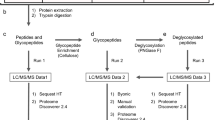Abstract
POLYSIALIC acid (PSA) is a dynamically regulated product of post-translational modification of the neural cell adhesion molecule, NCAM1,2. Presence of the large anionic carbohydrate modulates NCAM binding properties and, by increasing the intercellular space, influences interactions between other cell surface molecules1–5. PSA expression underlies cell type- and developmental-specific alterations6 and correlates with stages of cellular motility6–8. In the adult, PSA becomes restricted to regions of permanent neural plasticity and regenerating neural and muscle tissues6,9,10. Recent data implicate its important function in spatial learning and memory11,12, and in tumour biology13–16. Here we describe the molecular characterization of polysialyltransferase-1, the key enzyme of eukaryotic PSA synthesis. In reconstitution experiments, the newly cloned enzyme induces PSA synthesis in all NCAM-expressing cell lines. Our data therefore represent convincing evidence that the polycondensation of α–2,8–linked sialic acids in mammals is the result of a single enzymatic activity and provide a new basis for studying the functional role of PSA in neuro- and tumour biology.
This is a preview of subscription content, access via your institution
Access options
Subscribe to this journal
Receive 51 print issues and online access
$199.00 per year
only $3.90 per issue
Buy this article
- Purchase on Springer Link
- Instant access to full article PDF
Prices may be subject to local taxes which are calculated during checkout
Similar content being viewed by others
References
Hoffman, S. & Edelman, G. M. Proc. natn. Acad. Sci. U.S.A. 80, 5762–5766 (1983).
Rutishauser, U., Acheson, A., Hall, A. K., Mann, D. L. & Sunshine, J. Science 240, 53–57 (1988).
Acheson, A., Sunshine, J. L. & Rutishauser, U. J. Cell Biol. 114, 143–153 (1991).
Yang, P., Yin, X. & Rutishauser, U. J. Cell Biol. 116, 1487–1496 (1992).
Doherty, P., Cohen, J. & Walsh, F. S. Neuron 5, 209–219 (1990).
Edelman, G. M. A. Rev. Cell Biol. 2, 81–116 (1986).
Tang, J., Landmesser, L. & Rutishauser, U. Neuron 8, 1031–1044 (1992).
Landmesser, L. J. Neurobiol. 23, 1131–1139 (1992).
Martini, R. & Schachner, M. J. Cell Biol. 106, 1735–1746 (1988).
Daniloff, J. K., Levi, G., Grumet, M., Rieger, F. & Edelman, G. M. J. Cell Biol. 103, 929–945 (1986).
Cremer, H. et al. Nature 367, 455–459 (1994).
Tomasiewicz, H. et al. Neuron 11, 1163–1174 (1993).
Moolenaar, C. E. C. K. et al. Cancer Res. 50, 1102–1106 (1990).
Takamatzu, K. et al. Cancer Res. 64, 2598–2603 (1994).
Komminoth, P., Roth, J., Lackie, P. M., Bitter-Suermann, D. & Heitz, P. U. Am. J. Pathol. 139, 297–304 (1991).
Kern, W. F., Spier, C. M., Miller, T. P. & Grogan, T. M. Leukemia Lymphoma 12, 1–10 (1993).
McCoy, R. D., Vimr, E. R. & Troy, F. A. J. biol. Chem. 260, 12659–12699 (1984).
Kitazume, S., Kitajima, K., Inoue, S., Inoue, Y. & Troy, F. A. J. biol. Chem. 269, 10330–10340 (1994).
Block, R. J. J. Cell Biol. 116, 449–463 (1992).
Frosch, M., Görgen, I., Boulnois, G. J., Timmis, K. N. & Bitter-Suermann, D. Proc. natn. Acad. Sci. U.S.A. 82, 1194–1198 (1985).
Bierhuizen, M. F. A., Mattei, M.-G. & Fukuda, M. Genes Dev. 7, 468–478 (1993).
Seed, B. & Aruffo, A. Proc. natn. Acad. Sci. U.S.A. 84, 3365–3369 (1987).
Häyrinen, J., Bitter-Suermann, D. & Finne, J. Molec. Immun. 26, 523–529 (1989).
Drickamer, K. Glycobiology 3, 2–3 (1993).
Klein, P., Kanehisa, M. & DeLisi, C. Biochim. biophys. Acta 815, 468–471 (1985).
Livingston, B. D. & Paulson, J. C. J. biol. Chem. 268, 11504–11507 (1993).
Nara, K. et al. Proc. natn. Acad. Sci. U.S.A. 91, 7952–7956 (1994).
Sasaki, K. et al. J. biol. Chem. 269, 15950–15956 (1994).
Higgins, D. G. & Scharp, P. M. Gene 73, 237–244 (1988).
Tomlinson, S. & Taylor, P. W. J. Virol. 55, 374–378 (1985).
Gerardy-Schahn, R. & Eckhardt, M. Int. J. Cancer 8 (suppl.), 38–42 (1994).
Author information
Authors and Affiliations
Rights and permissions
About this article
Cite this article
Eckhardt, M., Mühlenhoff, M., Bethe, A. et al. Molecular characterization of eukaryotic polysialyltransferase-1. Nature 373, 715–718 (1995). https://doi.org/10.1038/373715a0
Received:
Accepted:
Issue Date:
DOI: https://doi.org/10.1038/373715a0
This article is cited by
-
Differential effect of disease-associated ST8SIA2 haplotype on cerebral white matter diffusion properties in schizophrenia and healthy controls
Translational Psychiatry (2018)
-
Intrabodies against the Polysialyltransferases ST8SiaII and ST8SiaIV inhibit Polysialylation of NCAM in rhabdomyosarcoma tumor cells
BMC Biotechnology (2017)
-
X-ray crystallographic structure of a bacterial polysialyltransferase provides insight into the biosynthesis of capsular polysialic acid
Scientific Reports (2017)
-
Generation and intracellular trafficking of a polysialic acid-carrying fragment of the neural cell adhesion molecule NCAM to the cell nucleus
Scientific Reports (2017)
-
An efficient cell free enzyme-based total synthesis of a meningococcal vaccine candidate
npj Vaccines (2016)
Comments
By submitting a comment you agree to abide by our Terms and Community Guidelines. If you find something abusive or that does not comply with our terms or guidelines please flag it as inappropriate.



